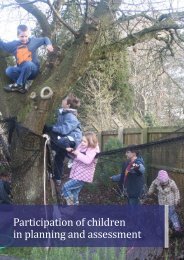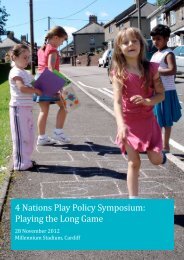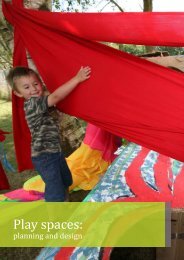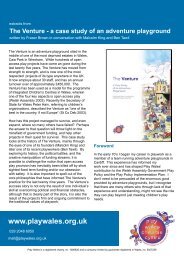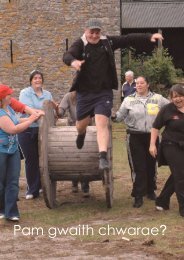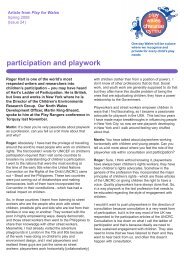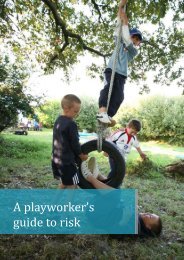Download Glossary of playwork terms - Play Wales
Download Glossary of playwork terms - Play Wales
Download Glossary of playwork terms - Play Wales
Create successful ePaper yourself
Turn your PDF publications into a flip-book with our unique Google optimized e-Paper software.
July 2009<br />
<strong>Glossary</strong> <strong>of</strong> <strong>playwork</strong> <strong>terms</strong><br />
Adult led agendas<br />
Reasons for doing things on the basis <strong>of</strong> adult<br />
ideas, needs or wishes<br />
Adulteration<br />
<strong>Play</strong> being controlled or spoiled by adults<br />
Advocate for play<br />
Publicly support and promote the importance<br />
<strong>of</strong> play<br />
Affective play space<br />
A space that pays attention to and supports<br />
the variety <strong>of</strong> feelings and moods that children<br />
and young people bring with them or have<br />
during play. The space has particular areas,<br />
materials and or props that at different times,<br />
stimulate or encourage expression, experience<br />
or experimentation with a range <strong>of</strong> emotions<br />
Annihilation<br />
When play ends or is stopped<br />
Anti-discriminatory practice<br />
Taking positive action to counter<br />
discrimination; this will involve identifying<br />
and challenging discrimination and being<br />
positive in your practice about diversity without<br />
compromising the right <strong>of</strong> individuals to play<br />
Battery children<br />
Children reared in a confined and controlled<br />
way without freedom to play out independently<br />
Behavioural modes<br />
The characteristics and essential manner <strong>of</strong><br />
play behaviour<br />
Biological drive<br />
Natural inborn urge<br />
Child and play centred<br />
<strong>Play</strong>work that responds to the play needs <strong>of</strong><br />
the children, not to external requirements<br />
Child protection<br />
The duty <strong>of</strong> adults to care for children in such<br />
a way that neither they nor others cause<br />
harm to children and to report and record all<br />
concerns related to a child being harmed (see<br />
also safeguarding children)<br />
Children’s rights<br />
Children’s entitlements under law and the<br />
United Nations convention on the Rights <strong>of</strong><br />
the child, particularly in relation to play and<br />
decisions that affect them<br />
Children and young people<br />
All children and young people <strong>of</strong> school age<br />
with respect for any impairment, their gender,<br />
race, culture, language, sexuality, health,<br />
economic or social status and any other<br />
individual characteristics<br />
Compensatory play<br />
Supplementary play experiences for children<br />
to choose from that aim to compensate for<br />
missing play opportunities in their lives<br />
Compensatory space<br />
A play space that takes account <strong>of</strong> what is<br />
available to children elsewhere in their local<br />
area and aims to make up for shortfalls<br />
in possibility by <strong>of</strong>fering an alternative<br />
environment<br />
Consultation<br />
An active two-way process <strong>of</strong> informing and<br />
involving individuals and groups to encourage<br />
the sharing <strong>of</strong> ideas, views and opinions<br />
especially in order to reach an agreed decision
Containment<br />
Supporting play by providing a ‘virtual’ shield<br />
against interference<br />
Discrimination<br />
Make unjust distinctions or fail to recognise<br />
support needs resulting in failure to<br />
acknowledge an individual’s right to participate<br />
in play and exercise freedom <strong>of</strong> choice<br />
Display<br />
Lack <strong>of</strong> response to a play cue that prevents<br />
the play from going forwards<br />
Dynamic risk assessment<br />
Active ongoing risk assessment <strong>of</strong> situations<br />
as they occur - usually taking place as a<br />
mental rather than a written process<br />
Ecological well-being<br />
Good balanced relationship between the play<br />
space and all the players<br />
Environmental hazards<br />
Things within the environment that may cause<br />
harm<br />
Equal Opportunities<br />
Recognising that play is for all children - we<br />
are all different and different children have<br />
different things to <strong>of</strong>fer and different needs to<br />
be met. Equal opportunities means supporting<br />
every child with respect and fairness<br />
Facilitate experimentation<br />
Create the right environment and atmosphere<br />
to enable children to experiment<br />
Flow<br />
The natural course <strong>of</strong> uninhibited play – where<br />
children are immersed in what they are doing<br />
and unaware <strong>of</strong> what is going on around them<br />
Gender socialisation<br />
The social pressure exerted on a child to<br />
behave in a way associated with being either<br />
male or female<br />
Hazard<br />
Something that may cause harm to the<br />
health, safety or welfare <strong>of</strong> users <strong>of</strong> the play<br />
environment<br />
Inclusion<br />
Ensuring that play provision is open and<br />
accessible to all and takes positive action<br />
in removing barriers so that all children can<br />
participate<br />
Impact absorbent surface<br />
Safety surfacing<br />
Impairments<br />
An individual physical, psychological or<br />
emotional make-up which differs from<br />
accepted norms<br />
Intervention Styles<br />
A range <strong>of</strong> methods the <strong>playwork</strong>er can use in<br />
the play environment. These may range from<br />
complete non-involvement through to specific<br />
intervention to enhance the children’s play<br />
Intrinsically motivated<br />
Internally driven reasons for doing something<br />
Loose Parts<br />
Materials that can be used flexibly for play –<br />
they can be moved around, manipulated, used<br />
as props or to change the environment<br />
Meta-communication<br />
Deep and subtle communication that gives a<br />
real indication <strong>of</strong> what is being meant beyond<br />
any words that are being said for example;<br />
non-verbal play cues; intonation <strong>of</strong> voice; facial<br />
expressions; body movements<br />
Metalude<br />
The action <strong>of</strong> the brain that produces the<br />
desire to play and issues a play cue (see play<br />
cue below)<br />
Monitoring and evaluation<br />
Regularly observing, checking and keeping<br />
and eye on specific aspects <strong>of</strong> the provision<br />
and then assessing whether they are fulfilling<br />
their intended purpose<br />
Narrative frame<br />
A story line that keeps the play going<br />
Observe<br />
Watch children’s play behaviors and the<br />
response <strong>of</strong> adults to ensure that the<br />
environment continues to provide effective<br />
play spaces
Overlapping play frames<br />
The real or imagined boundaries that keep<br />
in tact the different play <strong>of</strong> individual, and<br />
groups <strong>of</strong>, children who are using the same<br />
environment to play at different things, but at<br />
the same time<br />
Personal Care<br />
Provision <strong>of</strong> personal and intimate care to<br />
disabled children or very young children who<br />
are unable to provide care for themselves<br />
<strong>Play</strong> audit<br />
An inventory <strong>of</strong> play provision, or the play<br />
opportunities available<br />
<strong>Play</strong> Cue<br />
Facial expressions, language or body<br />
language that communicates the child or<br />
young person’s wish to play or invite others to<br />
play<br />
<strong>Play</strong> deprivation<br />
Notion that if children do not play they will lack<br />
experience that is developmentally essential<br />
and this may lead to them being biologically<br />
and socially disabled<br />
<strong>Play</strong> frame<br />
The real or imagined boundary that keeps the<br />
play intact<br />
<strong>Play</strong> impoverished<br />
Lacking in play potential<br />
<strong>Play</strong> type<br />
Different kinds <strong>of</strong> play that can combine to<br />
make up children’s play behaviour<br />
<strong>Play</strong>work curriculum<br />
The essential experiences <strong>playwork</strong>ers make<br />
available to children that fall into the categories<br />
<strong>of</strong> – The elements, Identity, Concepts and The<br />
Senses<br />
<strong>Play</strong>work Principles<br />
The pr<strong>of</strong>essional and ethical framework for<br />
<strong>playwork</strong><br />
<strong>Play</strong>work theory<br />
The researched information that is relative<br />
to <strong>playwork</strong> and informs the way that it is<br />
practiced<br />
Reflective practice<br />
<strong>Play</strong>workers’ ongoing thinking about their work<br />
and identifying what they do well and what<br />
they could improve<br />
Resilience<br />
Ability to recover quickly from difficult<br />
circumstances<br />
Return<br />
The response to a play cue (see play cue<br />
above)<br />
Rhythmical narrative<br />
A rhythm that keeps the play going<br />
Risk<br />
The possibility <strong>of</strong> a hazard actually causing<br />
harm<br />
Safe boundary<br />
A time and place (and the presence <strong>of</strong><br />
<strong>playwork</strong>ers) that creates a sense <strong>of</strong> security<br />
for playing<br />
Safeguarding<br />
Term used to describe a whole range <strong>of</strong> ways<br />
that adults help protect children and keep<br />
them safe from harm<br />
www.playwales.org.uk<br />
Registered charity no. 1068926<br />
A company limited by guarantee, no. 3507258<br />
Registered in <strong>Wales</strong>





